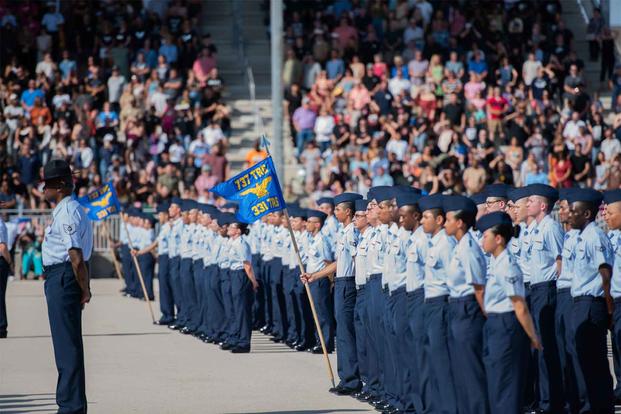
Air and Space Force recruits’ first five days of basic military training at Joint Base San Antonio-Lackland, Texas, will be different starting next month as the services focus on stress management, nutritional guidance and sleep hygiene to increase the odds of those recruits getting through.
The changes, set to take place the first week of October, will reorganize many of the existing classes that teach airmen and Guardians the basics of physical fitness, training and wellness throughout the 7½ weeks of boot camp and front-loads their first five days — called “zero week” — with that information.
Keeping airmen and Guardians in the service and making sure they make it through basic military training has become a top priority for the Department of the Air Force as it grapples with one of the toughest recruiting environments in decades.
“By aligning training modules together that address human performance factors such as sleep hygiene, stress management and nutrition, along with allowing trainees to build relationships with their teammates, we can directly impact a trainee’s path,” Lt. Col. Daniel Cassidy, director of human performance for the 37th Training Wing, said in a press release.
While no new curriculum is being introduced, it’s being rearranged in the hopes that it’ll give those recruits the skills they need for the remainder of basic military training. Cassidy equated the previous structure to throwing recruits in the deep end of a swimming pool to teach them how to swim, while the new curriculum focuses on fundamentals.
“Before, we were maybe teaching swim technique a little bit in the pool, but a lot in open water,” Cassidy said in a reporters roundtable on Friday.
In December, the service conducted a beta-test with two squadrons where they rearranged the curriculum for zero week and noticed multiple changes, including “the most prominent being an increase in physical fitness,” according to the press release.
Specific data was not provided, but the changes produced “a noticeable decrease in injuries and a noticeable increase in PT pass rates,” according to the service.
Earlier this month, at the Air and Space Force Association’s conference at National Harbor, Maryland, Secretary Frank Kendall said the service is on track to miss its recruiting goal this fiscal year, which ends this weekend, by 10%.
The last time the Air Force did not reach 100% of its recruitment goal was 1999, according to the Air Force Recruiting Service. That was when Millennials, who were born between 1981 and 1996, first began to reach the age of service. In 1979, the Air Force also missed its goals when Generation X began to reach the age to serve, according to a 2002 research paper from Air University.
One factor contributing to that is a large pool of ineligible Americans. The Pentagon has released studies showing that only 23% of American youth are eligible to serve due to being overweight, using drugs, or having mental and physical health problems.
Col. Lauren Courchaine, the 37th Training Wing commander, praised the changes for airmen and Guardians, saying it sets a necessary foundation for the new recruits.
“The changes in BMT [basic military training] will make our force stronger, more capable and better prepared for future challenges,” Courchaine added. “We need airmen and Guardians who aren’t just physically and mentally prepared but are profoundly motivated to be highly productive members of the Air and Space Force.”
This marks the second major change to basic military training since November, when the Air Force announced that it is getting rid of BEAST week, the four-day-long deployed war exercise that has been a staple of the service’s boot camp for the last 16 years.
It was replaced by a new exercise called PACER FORGE, a lengthy acronym that stands for the Primary Agile Combat Employment Range, Forward Operations Readiness Generation Exercise.
As the Department of the Air Force pushes its new philosophy of establishing “multi-capable airmen” — meaning it wants to have troops able to take on more responsibilities so they can carry out missions with fewer people — the new exercise develops trainees for a variety of missions in their careers, including “base operating support functions,” the release said.
During the new PACER FORGE exercise, airmen “deploy to the former BEAST site” and “will be put to the test with scenarios that are built to provide flexibility, promote information seeking, teamwork, decision making and are results focused,” the service detailed in a press release last year.
Space Force Guardians, who also attend basic military training at Joint Base San Antonio-Lackland, are also going through PACER FORGE during boot camp.
— Thomas Novelly can be reached at [email protected]. Follow him on X @TomNovelly.
Related: Air Force to Miss Recruiting Goals for First Time in More Than 2 Decades






